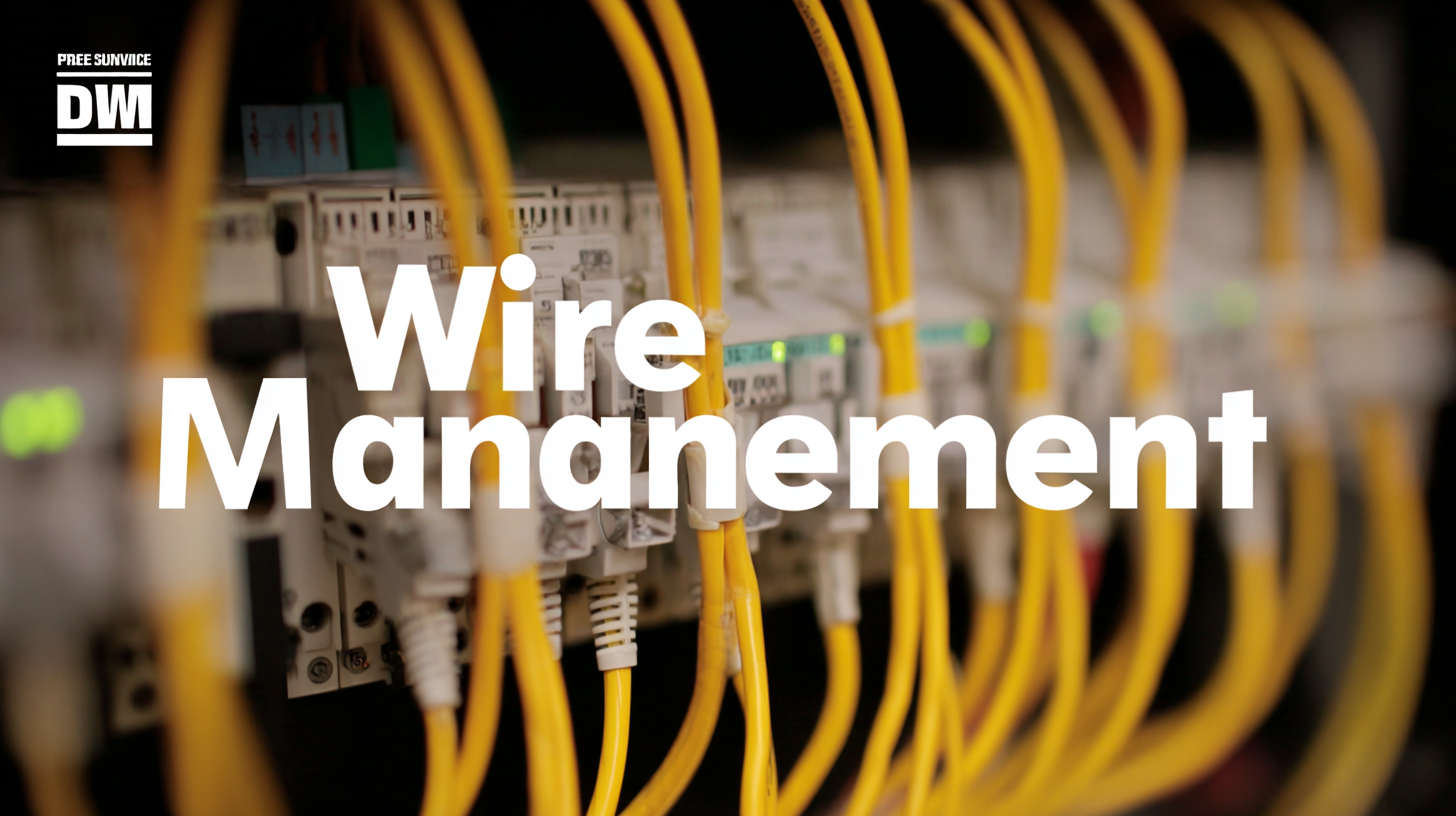In today's technology-driven world, efficient wire management stands as a critical component in ensuring operational excellence across various industries. A recent report by the International Wire and Cable Association highlights that poor wire management can lead to a staggering 30% increase in maintenance costs, underscoring the importance of streamlined wire organization.

As businesses increasingly rely on a complex web of cables and connections, the demand for effective wire management solutions continues to grow. This blog aims to explore the top strategies for achieving optimum wire management, focusing on how to identify high-quality suppliers who can provide tailored solutions.
By adopting best practices in wire management, organizations can not only enhance safety and efficiency but also significantly reduce downtime and maintenance expenses. Join us as we delve into this essential aspect of operational management.
Effective wire management is crucial in modern environments, particularly as organizations increasingly rely on advanced technology and interconnected devices. A recent report by the International Data Corporation (IDC) highlights that data center floor space costs have skyrocketed, propelling businesses to prioritize efficient wire management solutions to optimize their physical infrastructure. According to the report, nearly 70% of IT professionals indicated that poorly managed cables lead to inefficiencies, resulting in disruptions that can affect performance and increase maintenance costs by up to 30%.
The significance of wire management extends beyond just aesthetics; it plays a vital role in safety and operational efficiency. The National Fire Protection Association (NFPA) emphasizes that disorganized cabling can contribute to fire hazards, as tangled wires obstruct air circulation and block access to critical equipment. In another industry survey, 62% of facilities managers reported that implementing effective wire management practices not only reduced risk but also enhanced productivity and compliance with safety regulations.
As technology continues to evolve, understanding and investing in robust wire management solutions will be essential for ensuring seamless operations in the ever-changing landscape of modern environments.
Effective wire management is crucial for maintaining organization and safety in any workspace. When addressing essential technical specifications, it's vital to choose the right cable materials and sizes to prevent overheating and ensure durability. Cables should be rated for the specific electrical load they will carry and the environment they will operate in, such as outdoor or high-heat areas. Utilizing high-quality materials not only enhances performance but also extends the lifespan of the wiring, reducing the need for frequent replacements.
Tips for effective wire management include labeling cords and cables clearly to avoid confusion during maintenance or upgrades. This simple step can significantly minimize downtime and improve workflow efficiency. Additionally, consider implementing cable management solutions such as cable trays, raceways, or spiral wraps to keep wires organized and prevent tangling. These systems not only improve aesthetics but also ensure compliance with safety regulations, reducing the risk of accidents caused by loose or exposed wires.
Lastly, regularly inspecting your wire management strategy can help identify potential issues before they escalate. Maintaining an organized and well-documented system enhances both the safety and functionality of your electrical infrastructure, supporting overall productivity in your operations.
| Strategy | Description | Technical Specification | Benefits |
|---|---|---|---|
| Cable Tiers | Utilizing vertical tiers for organized wiring. | Material: Steel; Height: Adjustable. | Improves accessibility and maintenance. |
| Cable Management Panels | Panels to hold and route cables efficiently. | Material: Plastic; Size: 19-inch rack mount. | Reduces cable clutter and tangling. |
| Cable Ties | Using ties to group cables together. | Material: Nylon; Length: 8 inches. | Easy to install and reuse; versatile. |
| Wire Loops | Using loops to anchor and secure wires. | Material: Rubber; Size: 3 inches. | Prevents stretching and breakage. |
| Labeling Systems | Labeling cables for easy identification. | Material: Printable tags; Adhesive: Strong. | Simplifies troubleshooting and maintenance. |
Designing an effective wire management system is essential for maintaining a tidy and functional workspace. The first step in this process involves assessing the specific needs of your environment. Identify the types and volumes of wires you will be managing, whether they belong to computers, lighting, or other electronic devices. Understanding the layout of your space can help you determine the best pathways for wires, minimizing clutter and potential hazards.
Next, consider implementing a variety of organizational tools. Cable trays, wall clips, and zip ties can all play a vital role in keeping wires secure and out of sight. When attaching wires to surfaces, ensure that you leave some slack to accommodate any necessary adjustments or changes in configuration. Additionally, using color-coded labels can simplify identification, making it easier to trace wires back to their sources. By following these steps, you create a streamlined wire management system that not only enhances the aesthetics of your space but also improves overall efficiency.

In today’s fast-paced technological landscape, effective wire management is essential not only for aesthetic purposes but also for enhancing safety and efficiency. According to a report by the Consumer Electronics Association, businesses can save an average of 10% on maintenance costs by implementing effective wire organization strategies. Innovative tools such as cable trays, routing clips, and zip ties are revolutionizing the way companies approach wire management. These products not only help reduce clutter but also facilitate easier access to wires when maintenance is needed.
**Tip:** Investing in color-coded wire labels can significantly enhance your organization efforts, making it easier to identify and manage different cables. Not only does this streamline operations, especially in complex setups, but it also minimizes the risk of errors during installation or repairs.
Furthermore, utilizing cable management sleeves can protect wires from external damage and prevent tangling. A research study indicated that 25% of workplace accidents are caused by tripping over loose cables. Proper wire management tools can dramatically reduce this risk, creating a safer working environment while contributing to operational efficiency.
**Tip:** Regular audits of your wire management system can help you stay ahead by identifying potential issues before they escalate, ensuring your organization remains both safe and efficient.

In wire management implementation, avoiding common mistakes is crucial to achieving an efficient system.
One significant mistake is neglecting the planning phase. Without a proper assessment of the space, cable types, and required pathways, organizations often find themselves tangled in cables.
A thorough planning phase allows for the identification of optimal routing and necessary materials, reducing the likelihood of chaotic setups.
Another frequent error is the failure to label cables effectively. Unlabeled wires create confusion and complicate troubleshooting, potentially leading to downtime.
Implementing a comprehensive labeling system, utilizing color codes or clear tags, ensures that personnel can easily identify each wire's purpose and origin.
This not only aids in maintenance but also supports future upgrades or changes.
Lastly, overlooking the importance of regular maintenance can lead to deteriorating wire systems. Over time, dust and debris can accumulate, causing wear and malfunction of the cables.
Schedule periodic inspections to clean and assess the condition of the wire management solutions.
By addressing these common pitfalls, organizations can create a more effective and reliable wire management strategy, ultimately improving overall operational efficiency.
